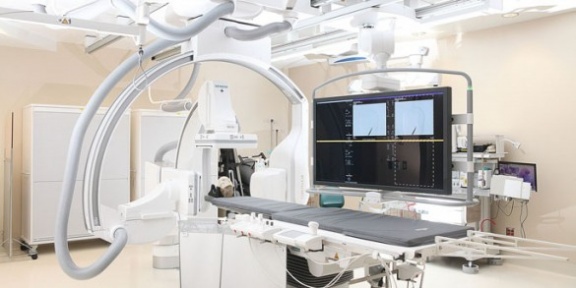A new advanced stroke treatment suite debuts this month at Vanderbilt University Medical Center, offering better care for patients with blood circulation problems in the head and neck, such as stroke and aneurysm.
The neuroangiography suite occupies operating rooms 1 and 8, and comprises two bi-plane imaging machines, including the new Siemens Artis Q, which offers improved image quality with lower doses of radiation.
“The two combined surgical suites with bi-plane angiography abilities give us unparalleled capacity to treat and cure cerebrovascular disease,” said J Mocco, M.D., M.S., associate professor of Neurological Surgery.
The machines allow neurosurgeons to visualize the blood flow in a patient’s brain in real time and repair any blockages or hemorrhaging.
“The bottom line is this gives us more efficiency, more emergency readiness and better quality of care because of the higher image quality and additional image processing features,” said Michael Froehler, M.D., Ph.D., assistant professor of Neurology and Neurosurgery.
The Siemens machine’s imaging capabilities will help providers make better and faster treatment decisions. It uses digital subtracted angiography to enhance the visualization of blood vessels using contrast dye.
A new tool called iFlow shows how far and how dense blood flow is using a color system. There is a virtual stenting tool that allows surgeons to simulate a stent on the computer to ensure it will fit before implanting into the patient.
“This new machine is on the cutting edge of radiological technology and gives us unprecedented abilities to care for patients,” said Buddy Connors, M.D., professor of Radiology, Neurology and Neurological Surgery.
The machine also takes CT scans and a 3-D image simultaneously, eliminating the need for separate scans for each. Plus it can recalibrate images if a patient moves or breathes.
“Overall, the higher image quality and faster processing will lead to better patient outcomes,” Froehler said. “It also means reduced X-ray exposure for the patient and the staff.”
Each OR is a hybrid room, meaning it has capacity for both open and minimally invasive surgeries, and can switch between the two mid-procedure.
Having the two rooms next to each other will also increase efficiency, with a central location for supplies and staffing.
“This unparalleled stroke suite makes us even more emergency ready, which is critical for stroke care,” Froehler said.
David Wyatt, MPH, R.N., administrative director of Perioperative Services, said providing this state of the art care is made possible by a team effort.
“The advancement of stroke treatment and the movement of this treatment to the Operating Room has allowed several teams — interventional radiology, surgery, anesthesiology, neurology and nursing — to create a single cohesive approach to stroke care. I have been impressed how these teams have come together to not just create a hybrid operating room, but a hybrid team that brings the necessary skill sets to the patient for the best care,” Wyatt said.
